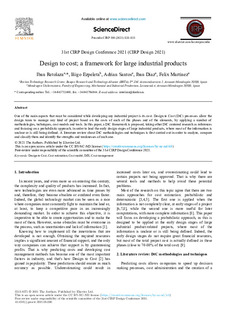Title
Design to cost; a framework for large industrial productsAuthor
Author (from another institution)
xmlui.dri2xhtml.METS-1.0.item-contributorOtherinstitution
https://ror.org/03hp1m080Version
http://purl.org/coar/version/c_970fb48d4fbd8a85
Rights
© 2021 by the authors. Published by Elsevier Ltd.Access
http://purl.org/coar/access_right/c_abf2Publisher’s version
https://doi.org/10.1016/j.procir.2021.05.036Published at
Procedia CIRP Vol. 100. Pp. 828-833, 2021xmlui.dri2xhtml.METS-1.0.item-publicationfirstpage
828xmlui.dri2xhtml.METS-1.0.item-publicationlastpage
833Publisher
Elsevier Ltd.Keywords
Design for assemblyDesign for assembly for large, heavy parts
Design for assembly on site
Design for installation
Abstract
A literature review on the assembly design methodologies (DfA) oriented to the assembly of large and heavy parts, reveals the need to develop a DfA methodology. In addition, the lack of DfA evaluation ... [+]
A literature review on the assembly design methodologies (DfA) oriented to the assembly of large and heavy parts, reveals the need to develop a DfA methodology. In addition, the lack of DfA evaluation methods for on-site assembly is also observed. The most widespread DfA methodologies are more oriented toward the improvement of factory assembly processes, where the assembly processes are well defined and standardised. Hence, this article presents a new methodology for the design of assemblies with large and heavy parts on site, called OSIA (On-Site Installation Analysis). OSIA methodology aims to provide data (indicators). On the one hand the theoretical basis of the OSIA methodology is based on three key concepts: i) analysis of assembly operations similar to the one used by the SMED methodology; ii) generic implementation process of DfA methodologies; and, iii) compilation of assembly operation times and estimation of standard times per operation. On the other hand, the steps in the implementation of the methodology are summarized in: i) database development with assembly operations and standard times; ii) assembly operations analysis; iii) calculation of assembly time; and iv) product optimization. In this way, OSIA methodology supports the designer in the specification phase, detailed design phase and in the redesign processes, providing the designer with indicators that make it possible to optimise the design of the parts and reduce the assembly operations of a product on site. [-]
Collections
- Articles - Engineering [684]
The following license files are associated with this item:
Except where otherwise noted, this item's license is described as Attribution-NonCommercial-NoDerivatives 4.0 International
Related items
Showing items related by title, author, creator and subject.
-
DC distribution grids: Providing comprehensive tools for a more efficient and reliable design
Mondragon Unibertsitatea (Mondragon Unibertsitatea, 2017-10-10)Researchers from Mondragon Unibertsitatea along with representatives from Ingeteam, S.A. offered atutorial about the most recent research related to the development of DC distribution grids at the European Conference on ... -
“Creativity in Design” Lehenengo jardunaldia.
Mondragon Unibertsitatea (Mondragon Unibertsitatea, 2010-11-25)Mondragon Unibertsitateko Goi Eskola Politeknikoan diseinuko sormen jardunaldia. -
Design Konferentziak Mondragon IV. edizioa
Mondragon Unibertsitatea (Mondragon Unibertsitatea, 2014-07-10)Ekainak 13an, Bilbao Berrikuntza Faktoriako eraikuntza berrian izan zen konferentzia.























